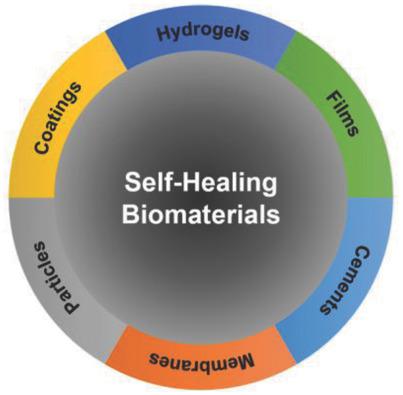当前位置:
X-MOL 学术
›
Adv. Mater. Interfaces
›
论文详情
Our official English website, www.x-mol.net, welcomes your feedback! (Note: you will need to create a separate account there.)
Self‐Healing Biomaterials: From Molecular Concepts to Clinical Applications
Advanced Materials Interfaces ( IF 5.4 ) Pub Date : 2018-04-03 , DOI: 10.1002/admi.201800118 Mani Diba 1, 2 , Sergio Spaans 1, 3 , Ke Ning 4 , Bastiaan D. Ippel 1, 3 , Fang Yang 4 , Bas Loomans 5 , Patricia Y. W. Dankers 1, 2, 3 , Sander C. G. Leeuwenburgh 4
Advanced Materials Interfaces ( IF 5.4 ) Pub Date : 2018-04-03 , DOI: 10.1002/admi.201800118 Mani Diba 1, 2 , Sergio Spaans 1, 3 , Ke Ning 4 , Bastiaan D. Ippel 1, 3 , Fang Yang 4 , Bas Loomans 5 , Patricia Y. W. Dankers 1, 2, 3 , Sander C. G. Leeuwenburgh 4
Affiliation

|
Biomaterials are being applied in increasingly complex areas such as tissue engineering, bioprinting, and regenerative medicine. For these applications, challenging—or even contradictory—combinations of biomaterial properties are often required which cannot be met by conventional biomaterials. During the past decade, several new concepts have been developed to render biomaterials self‐healing, thereby offering new opportunities to improve the functionality of traditional biomaterials in terms of their mechanical, handling, and biological properties. Consequently, various types of self‐healing polymeric, ceramic, or composite biomaterials have been developed. Nevertheless, despite the rapid emergence of the field of self‐healing biomaterials, this field of research has not been reviewed during the recent years. Therefore, this article provides a critical overview of recent progress in the field of self‐healing biomaterials research by discussing both extrinsic and intrinsic self‐healing systems. While the extrinsic self‐healing section focuses on self‐healing dental materials and orthopedic bone cements that rely on release of healing liquids from embedded microcapsules, the section on intrinsic self‐healing materials mainly discusses concepts for self‐healing of polymeric biomaterials that are either hydrated (hydrogels) or nonhydrated (e.g., films and coatings). Finally, benefits of the self‐healing feature for biomaterials are discussed, and directions for future research and developments are outlined.
中文翻译:

自我修复生物材料:从分子概念到临床应用
生物材料正在越来越复杂的领域中应用,例如组织工程,生物打印和再生医学。对于这些应用,通常需要具有挑战性甚至是矛盾的生物材料特性组合,而常规生物材料无法满足这些要求。在过去的十年中,已经开发了一些新的概念来使生物材料实现自我修复,从而为改善传统生物材料的机械,处理和生物学特性提供了新的机遇。因此,已经开发出各种类型的可自我修复的聚合物,陶瓷或复合生物材料。然而,尽管自愈生物材料领域迅速兴起,但近年来该研究领域尚未得到审查。所以,本文通过讨论外部和固有的自我修复系统,对自我修复生物材料研究领域的最新进展进行了重要的概述。外部自我修复部分着重于自修复牙科材料和骨科骨水泥的依赖,这些材料依靠从嵌入式微胶囊中释放愈合液,而固有自我修复部分则主要讨论高分子生物材料自我修复的概念,无论是水合的(水凝胶)或非水合的(例如薄膜和涂层)。最后,讨论了生物材料自我修复功能的好处,并概述了未来研究和开发的方向。外部自我修复部分着重于自修复牙科材料和骨科骨水泥的依赖,这些材料依靠从嵌入式微胶囊中释放愈合液,而固有自我修复部分则主要讨论高分子生物材料自我修复的概念,无论是水合的(水凝胶)或非水合的(例如薄膜和涂层)。最后,讨论了生物材料自我修复功能的好处,并概述了未来研究和开发的方向。外部自我修复部分着重于自修复牙科材料和骨科骨水泥的依赖,这些材料依靠从嵌入式微胶囊中释放愈合液,而固有自我修复部分则主要讨论高分子生物材料自我修复的概念,无论是水合的(水凝胶)或非水合的(例如薄膜和涂层)。最后,讨论了生物材料自我修复功能的好处,并概述了未来研究和开发的方向。,薄膜和涂料)。最后,讨论了生物材料自我修复功能的好处,并概述了未来研究和开发的方向。,薄膜和涂料)。最后,讨论了生物材料自我修复功能的好处,并概述了未来研究和开发的方向。
更新日期:2018-04-03
中文翻译:

自我修复生物材料:从分子概念到临床应用
生物材料正在越来越复杂的领域中应用,例如组织工程,生物打印和再生医学。对于这些应用,通常需要具有挑战性甚至是矛盾的生物材料特性组合,而常规生物材料无法满足这些要求。在过去的十年中,已经开发了一些新的概念来使生物材料实现自我修复,从而为改善传统生物材料的机械,处理和生物学特性提供了新的机遇。因此,已经开发出各种类型的可自我修复的聚合物,陶瓷或复合生物材料。然而,尽管自愈生物材料领域迅速兴起,但近年来该研究领域尚未得到审查。所以,本文通过讨论外部和固有的自我修复系统,对自我修复生物材料研究领域的最新进展进行了重要的概述。外部自我修复部分着重于自修复牙科材料和骨科骨水泥的依赖,这些材料依靠从嵌入式微胶囊中释放愈合液,而固有自我修复部分则主要讨论高分子生物材料自我修复的概念,无论是水合的(水凝胶)或非水合的(例如薄膜和涂层)。最后,讨论了生物材料自我修复功能的好处,并概述了未来研究和开发的方向。外部自我修复部分着重于自修复牙科材料和骨科骨水泥的依赖,这些材料依靠从嵌入式微胶囊中释放愈合液,而固有自我修复部分则主要讨论高分子生物材料自我修复的概念,无论是水合的(水凝胶)或非水合的(例如薄膜和涂层)。最后,讨论了生物材料自我修复功能的好处,并概述了未来研究和开发的方向。外部自我修复部分着重于自修复牙科材料和骨科骨水泥的依赖,这些材料依靠从嵌入式微胶囊中释放愈合液,而固有自我修复部分则主要讨论高分子生物材料自我修复的概念,无论是水合的(水凝胶)或非水合的(例如薄膜和涂层)。最后,讨论了生物材料自我修复功能的好处,并概述了未来研究和开发的方向。,薄膜和涂料)。最后,讨论了生物材料自我修复功能的好处,并概述了未来研究和开发的方向。,薄膜和涂料)。最后,讨论了生物材料自我修复功能的好处,并概述了未来研究和开发的方向。



























 京公网安备 11010802027423号
京公网安备 11010802027423号